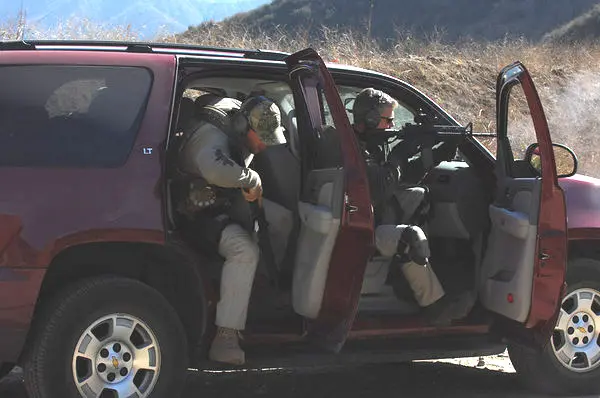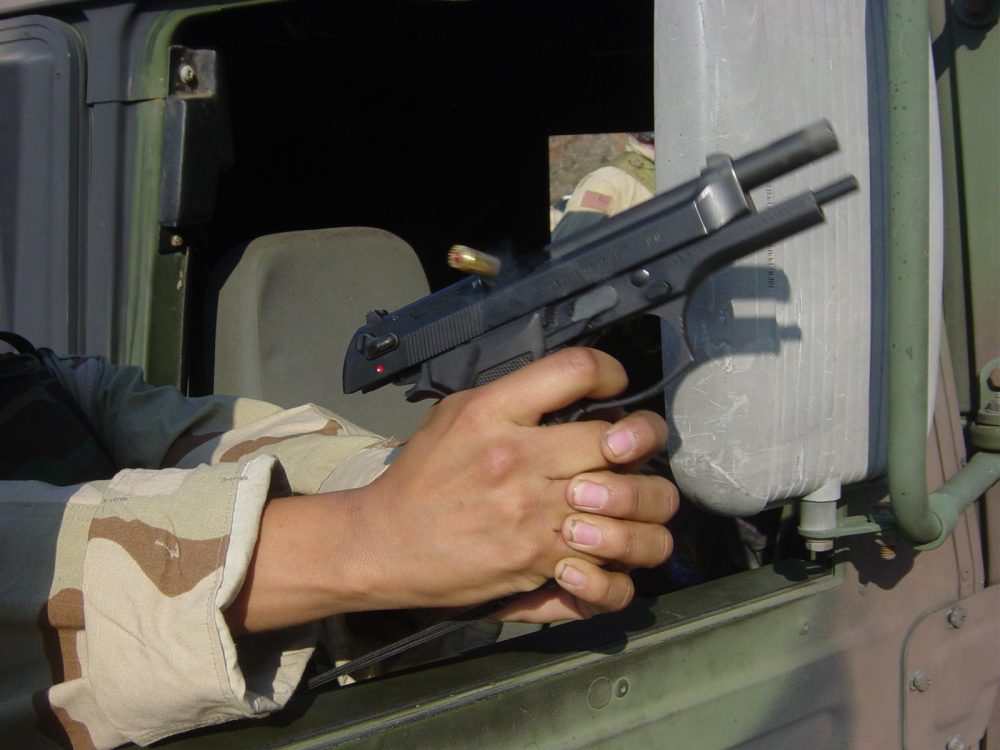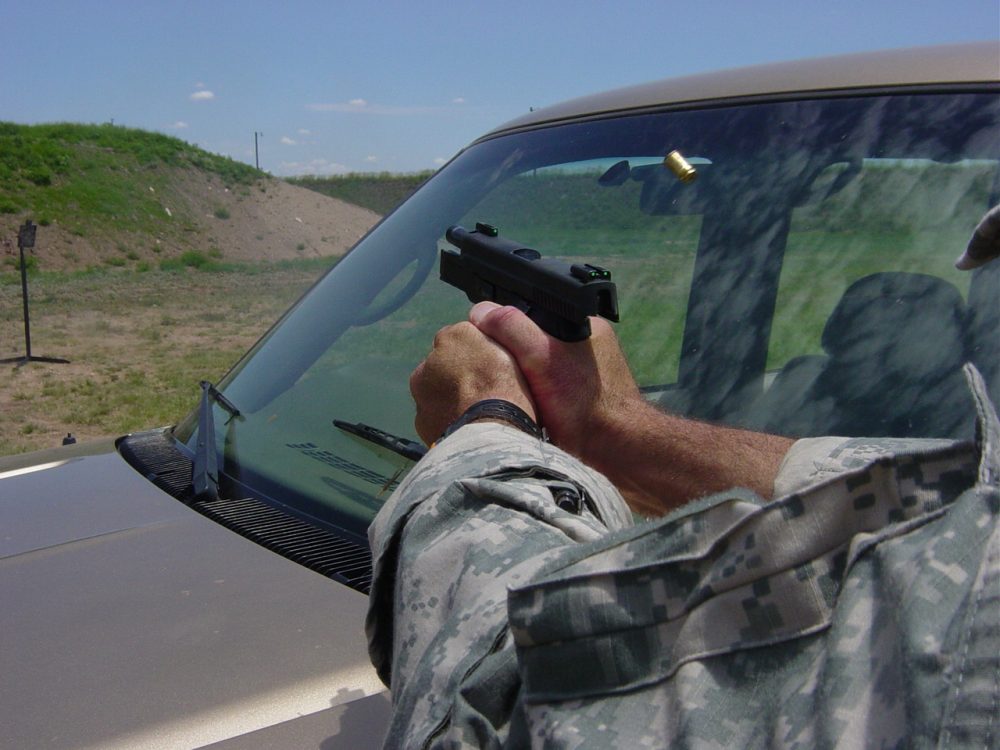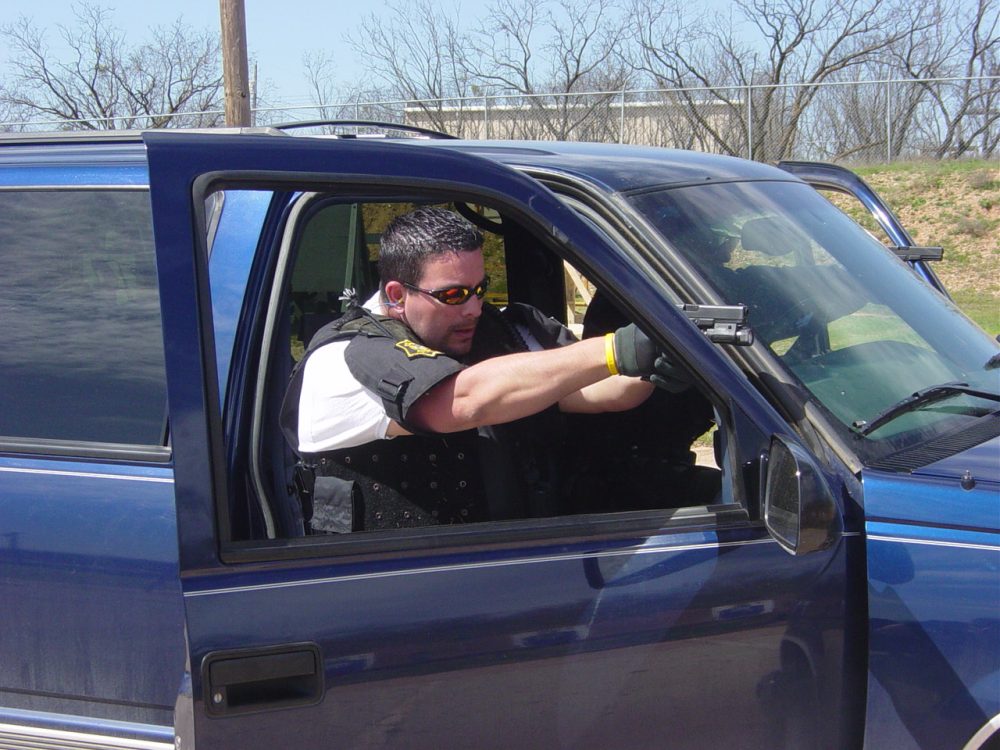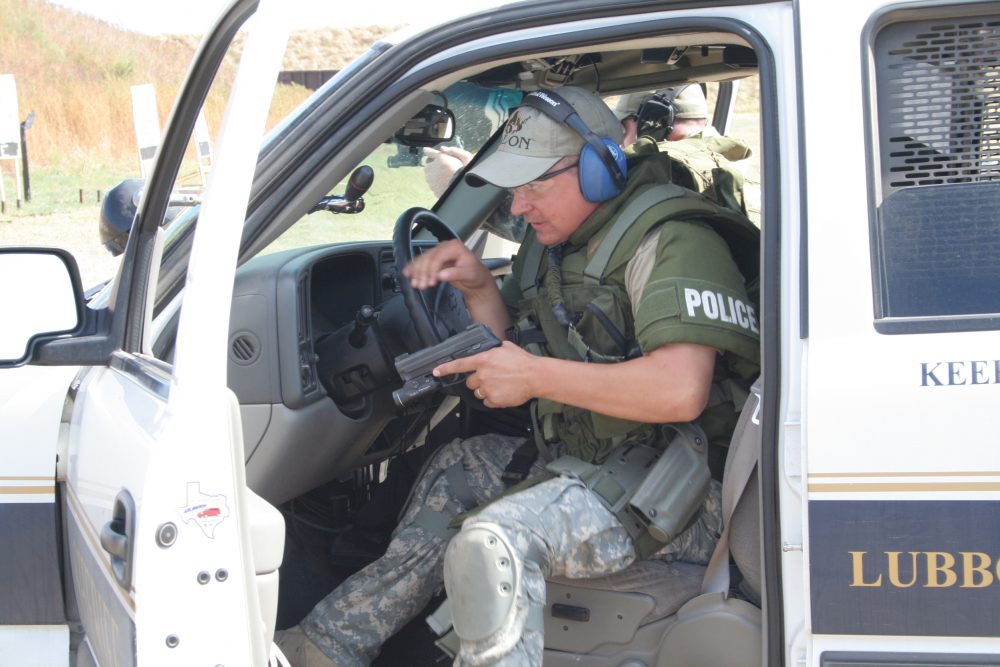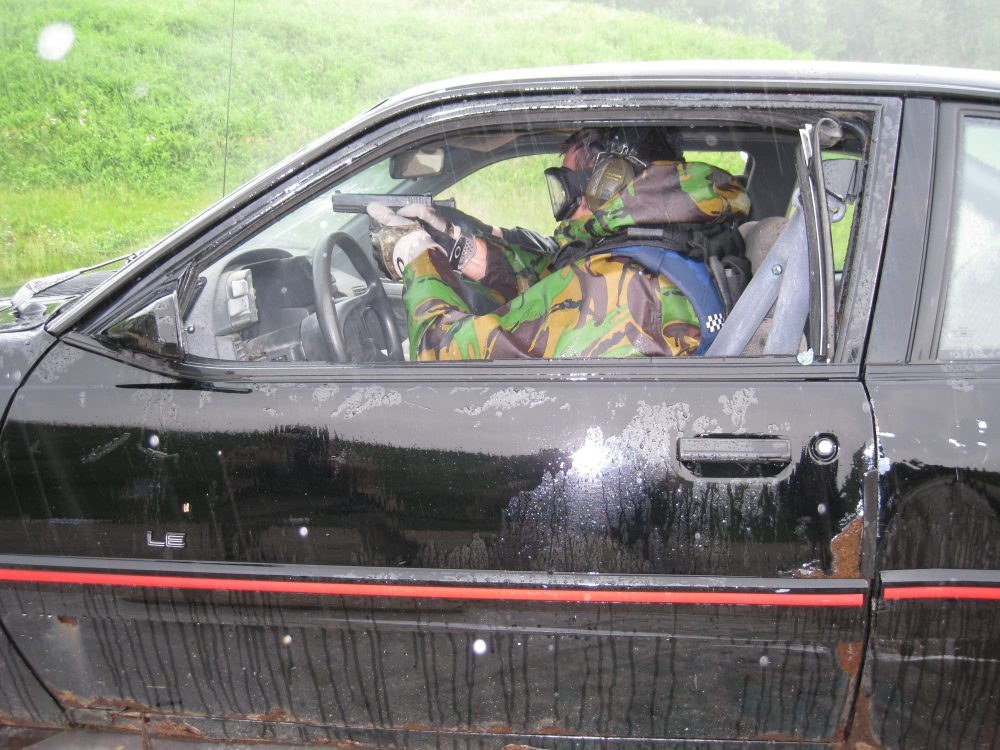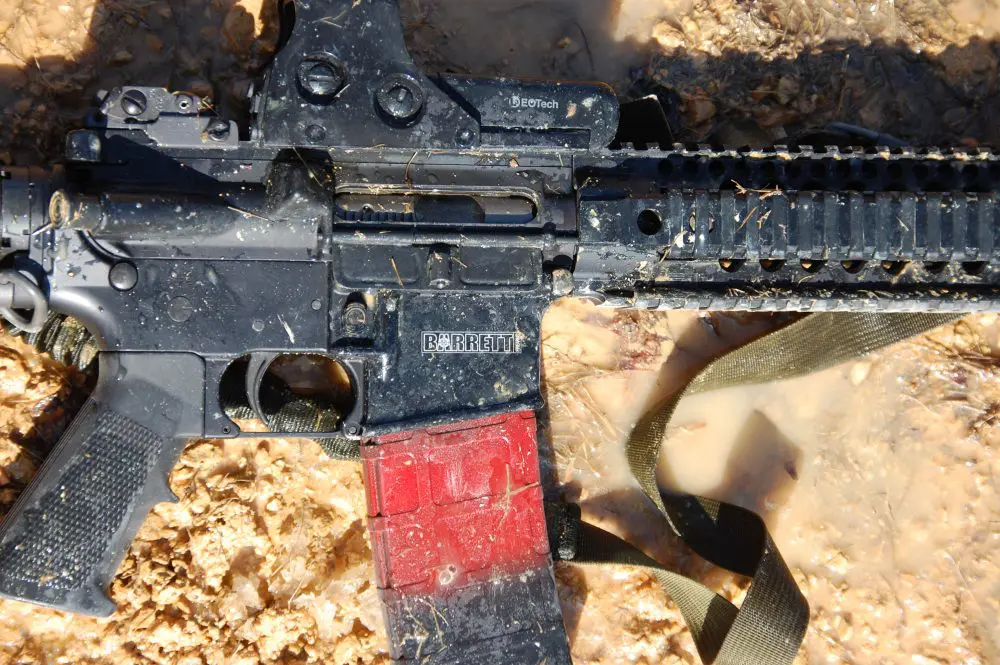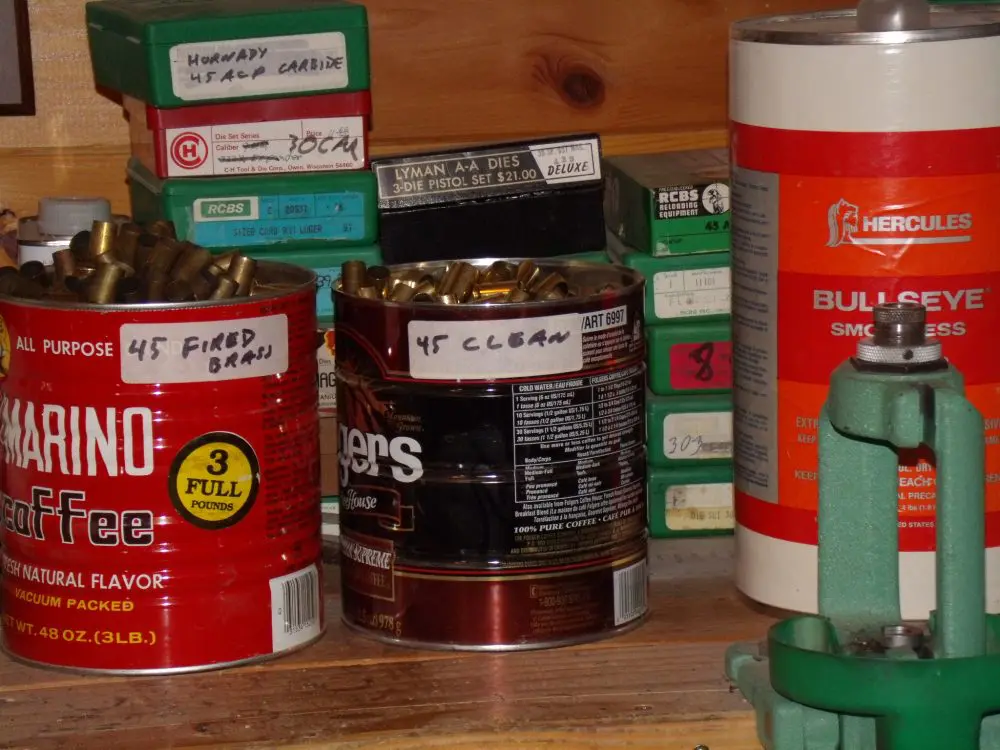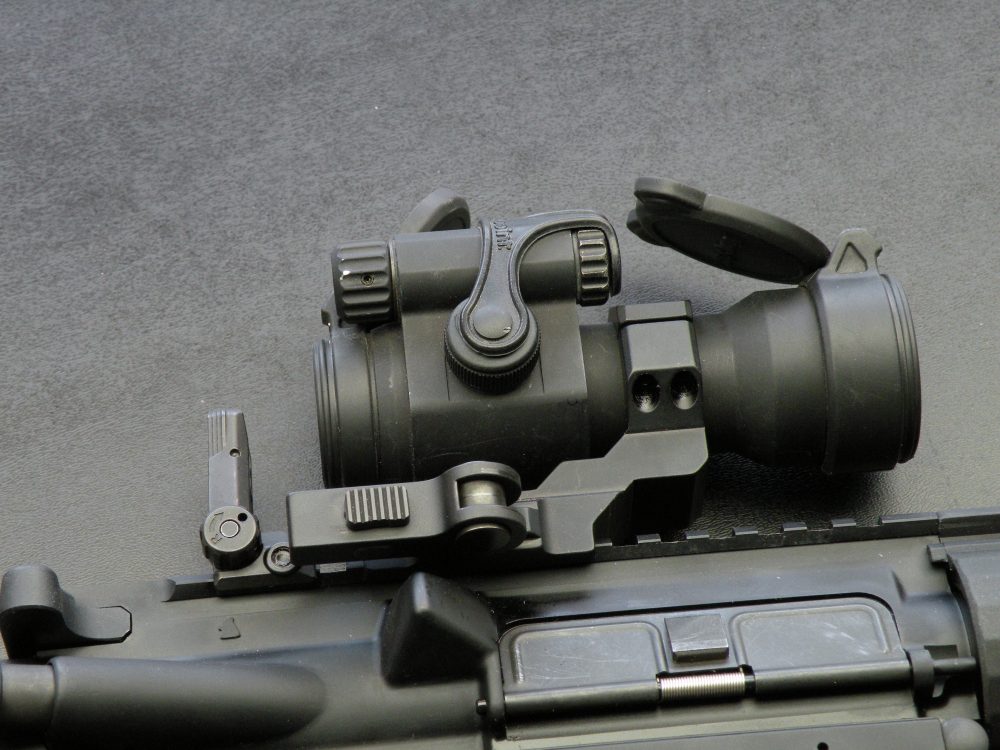We spend a great amount of time in our vehicle almost every day. We get in our car to drive to work, and then we get in the unit and drive patrol for eight to 12 hours.
Considering the amount of time we spend in and around our vehicle, it stands to reason that our chances of becoming involved in a lethal-force encounter during this time are high.
The contents of this article are critically important for every individual reading this who works in law enforcement or other high-risk environments. The mission is to share some points with police officers, soldiers and others operating in hostile theaters where they may be required to employ their firearms from in and around their vehicles.
When employing long guns, it is critical to have the muzzle clear of the Alpha post and also be aware of muzzle/optic offset.
Table of Contents
TRAINING
Our training should reflect reality as much as safety and common sense allow. If it does not, it is simply an exercise in futility. The amount of live-fire training time that focuses on vehicle engagements is surprisingly low. I have often thought about the reasons behind this.
First, I feel that many of the firearms instructors in charge of ranges lack the experience, motivation and imagination to implement hardcore and realistic drills involving vehicles, since most of their time is tasked with static range work.
I also believe there is always the fear that a vehicle will be shot by a student during these drills. This is the fault of the instructors for not demonstrating proper methods of shooting from in and around vehicles. I cannot count the times I have heard from range staff at various departments that “We don’t shoot from the cars anymore because we had a student shoot the spotlight/ram bar/hood/floor,” etc.
Sometimes the best defense is a good offense.
Clearly, there are two types of vehicles that should be employed during training—those that can be shot and those that cannot be shot. When we are using department or unit vehicles, it causes the commanders much dismay to come out and see their brand-new unit perforated with bullet holes.
When we are using no-shoot vehicles, we must make sure that the shooters have the muzzle of the weapon clear the body of the vehicle before they pull the trigger. When firing over the hood, the shooter needs to insure that his muzzle is well above the hood. Shorter shooters may need to shoot around the front grill if we are working with SUVs. With long guns, we also need to take into account the mechanical offset of the muzzle with any optics that we are using, to avoid putting rounds into the hood.
When shooter rests his wrists on the vehicle, recoil energy dumps straight into his hands, making this 9mm recoil more like a .44 Magnum.
SHOOT CARS
From a physics perspective, it is a fact that when incoming rounds strike the hood or trunk lid, they deflect off at a steeper angle than they came in on. With this in mind, it is solid tactics to teach the shooter to be back three to five yards from the vehicle when firing. From this distance, there is a higher likelihood that incoming skip rounds will deflect off the body of the vehicle, going over us. This is when we use shoot cars. I don’t care how experienced the shooters are, if you have them firing over the hood from three yards away, you will get a bullet strike on the car—probably sooner rather than later.
Shooting through windshields from the inside is invaluable to demonstrate the deflection of rounds. While all windshields are a little different, the general rule is that the round will rise about three feet if you are firing at a target seven yards in front of your glass. This rise is significant, and it is important that students are made aware of it. When firing through the glass, insure all shooters wear goggles and ideally dust masks or other cloth over their nose and mouth to protect from micro pulverized glass debris. Hit up junkyards frequently and get some shoot cars that the men can practice these techniques on.
When training with no-shoot vehicles, keep your weapon well above vital areas.
SEATBELTS
When do our seatbelts come off? I was taught many years ago and continue to teach that the seatbelt comes off when we are 30 seconds out or half a block away from our destination. If someone is going to ambush a cop, VIP Protection detail or private citizen, they are going to execute it at the arrival or departure from venues. Our countersurveillance skills are critical to lessen the chances of this happening, but we should always prepare for the worst.
I have repeatedly seen squared-away men under stress frantically struggling to exit the vehicle while their seatbelt is still fastened. I guarantee that the seatbelt will win that one. Conversely, on departures, the seatbelt should not be hooked up until we are 30 seconds out or half a block away from our venue. This should be normal SOP in our day-to-day routines.
Other general awareness issues include procedures when entering our vehicle. The first two priorities are to lock the door then start the car. Once these are accomplished, we can begin programming the GPS or logging into our computers, etc.
Shooter maintains low return-fire profile and has his muzzle clear of the Alpha post.
COUNTERAMBUSH PROCEDURES
Having mentioned ambushes, being caught in an ambush while in our vehicle is a real possibility both for soldiers and police. Once again, our highest chances of being hit occur while we are arriving at or departing from venues.
There are four basic options presented to us if we are caught in a vehicle ambush.
Drive Through
The safest way to survive a shootout is to not be there when it happens. This is where the drive-through option comes into play. For example, we may be taking sporadic hits from a hasty or distant ambush. The sooner we can get out of the kill zone, the safer we will be. We refer to this as “Duck your head, punch your gas, and pucker your ass.” Our vehicles will drive over or through many obstacles that would seem impossible to those who are not trained in high-speed vehicle maneuvers.
The driver should focus on nothing but driving! He is the man critical to our survival. He has one job in the universe—drive the car! Everyone else has one job also—protect the driver!
After multi-tasking of braking, throwing shifter into park and opening his door, driver still maintains perfect muzzle control and finger straight.
Ram Through
If we have the option, we should always use the most effective weapon at our disposal—our vehicle is our best weapon. Why reach for a four-pound weapon when we have a 4,000-pound one available? If the enemy deploys a barricade or vehicle blockade to stop our forward movement, the best option may be to ram through the obstacle.
Care should be taken as to the speed used when making contact with the barricade. The maxim that has been taught for quite awhile is to slow down as if we are going to stop. This will momentarily lull the enemy into thinking that we are in fact complying with their orders. When about 25 yards out, punch the gas and prepare for contact. Too high a rate of speed on our part may cause disabling damage to our vehicle. We are looking for contact with our front end and their rear axle to have the best leverage for pushing the barricade out of our path.
When shooting through glass in training, goggles are mandatory. Filtering your nose and mouth is also highly recommended.
Reverse Out
If the enemy has conducted surveillance on us and knows our SOP is to ram through any obstacles they present, they may choose to beef up their barricade. An armored car or cement truck will pose more of a formidable obstacle and will negate the ram-through option. In this case, either a straight reverse out or a J turn would be the next option. When involved in motorcade operations, coordinating this procedure with multiple vehicles in training is crucial.
Debus
The option to dismount is a critical decision. As we have discussed, it is best to drive through when possible. The debus would be performed on one of two occasions. First, if the vehicle is fatally disabled, it is becoming a bullet trap. Dynamically deploying from the vehicle using coordinated fire and movement may allow the passengers to move to a more advantageous defensible position.
A second reason the team may deploy from the vehicle is that it may be their stated mission to serve as a counter-assault force for a motorcade. While the principal’s vehicle is extracting from the kill zone, the counter-ambush team will deliver outgoing accurate firepower in order to close with, neutralize, and/or distract the threat.
All shooters have their muzzles well clear of the Alpha post of these no-shoot vehicles. Maintain this standard and you will have no problems.
ADDITIONAL POINTS
Always seek cover. Understand what parts of your vehicle will and will not stop incoming rounds. When we are in the front seat, the amount of cover is significant. Obviously the engine block will protect us from all but the most powerful rounds. The windshield has been known to deflect many rounds other than those coming in at a relatively straight trajectory. The support bar coming from the hood to the roof is known as the Alpha post. We have seen this post stop or radically deflect many pistol rounds and even many 5.56mm rounds.
Always be aware of your muzzle control. This is obviously the standard when we are shooting or moving on normal live-fire ranges, but inside the close confines of a vehicle cockpit, it becomes much more critical because the room for error is much smaller. While we are scrambling across seats and providing covering fire for our teammates who are deploying from the vehicle, we must be cognizant that our muzzles never flag them or any part of our body. Dry-fire runs are highly recommended until shooters become accustomed to this dynamic and somewhat physically demanding procedure.
Great vigilance needs to be maintained at all arrivals and departures.
Keep your finger straight except when actually firing. Once again, this is a no-brainer on the square range, but during emergency debus drills, we may be firing through the windshield one second, then the next second be opening our doors to deploy. During this mental transition between firing and moving, our finger must come out of the trigger guard and our weapons must be either decocked or put back on safe.
Harden your vehicle’s ballistic resistance when possible. If we are tasked with an emergency assault across open ground, we had better make sure we have given ourselves every bit of ballistic protection at our disposal. This means possibly laying extra ballistic vests on the hood or even over or inside the doors. Sandbags might be an old concept, but they still perform just as well as they did 100 years ago. I will take one any day—as long as I don’t have to carry it.
Do not use the vehicle body for shooting support. Contrary to most peoples’ first response, using the vehicle body to stabilize our sights will not assist us in shooting more accurately. On the contrary, it is a detriment to our accuracy. Anchoring our weapons system to the vehicle body will reduce our ability to quickly traverse our arc of fire. We need to stay off the vehicle body when firing. If we have other officers exiting the vehicle while we are engaging, the body of the vehicle will be moving from the suspension system and therefore our sight picture will also be moving.
Alpha post will stop more than most people think.
In closing, a well-executed ambush is fast and violent, with a maximum amount of firepower brought to bear on the kill zone. As in any ambush, the faster those in the kill zone can drive through and get rounds on target, the better chance they have of surviving the ambush. Always use cover to its maximum, and remember that any cover is better than no cover.
Max Joseph has been involved in special operations and training non-stop for the last 27 years and is the founder and training director of both Tactical Firearms Training Team (TFTT) and the Direct Action Group. He has trained and worked with counter-terrorist officers and troops from Asia, Africa, Eastern Europe, the Middle East and South America. Max is recognized as a subject-matter expert in explosives for tactical breaching and other special operations. He also has extensive experience in executive protection and has worked details in Central America, South America, Eastern Europe and Afghanistan. He can be contacted at [email protected] or visit www.tftt.com.
